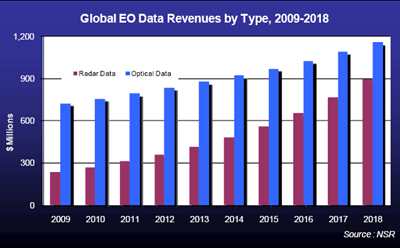NGA Has Commercial Radar Imagery on its Screen:
Contract to Foreign Data Providers is a Sign of Changing Mindset The recent award by the U.S. National Geospatial-Intelligence Agency (NGA) of three contracts for radar data is a change in direction for the largest U.S. customer of commercial satellite imagery. Two of the three firms that received the award are non-U.S. companies, and all data sets will come from foreign-owned satellites.
EADS/Astrium (France), Lockheed Martin Space Systems, and MDA (Canada) were each at the good end of a contract that could reach $85 million over the next five years. The previous largest contracts for NGA imagery purchase from commercial sources involved U.S.-based GeoEye and DigitalGlobe and even if NGA purchased from non-U.S. sources in the past, the use of commercial SAR is a first in this case. This could have a ripple effect to other allied nations around the world as they assess the usefulness of this type of data.
If we go back about ten years, the U.S. tried to control as much as possible the advances in sensors onboard SAR satellites, and some of its policies were instrumental in keeping higher resolution SAR imagery from reaching all corners of the globe. This certainly had a deterrent on the neighbor from the north, which had its plans for higher resolution commercial SAR satellites curtailed by concerns from the U.S. Defense Department and former administrations' sensitivities. However, this coupled with the 'shutter control' policy affecting distribution of imagery below one meter in resolution also aimed to protect the U.S. industry but in effect may have hampered their efforts to fund and operate commercial SAR solutions.
The effect was continued funding of radar satellites in Canada and Europe, and a specialty niche developed with quite a few new products offered with higher resolution and revisit time from foreign satellites.
The recent purchase by the NGA is likely to fuel sales of radar data from some of the industry's most sophisticated EO satellites, and the likely beneficiaries have many reasons to rejoice in the greater awareness that these agencies provide them. EADS will use TerraSAR-X currently in-orbit and the TanDEM-X satellite (to be launched this year), while Lockheed Martin Space Systems has Cosmo-Skymed radar data from the Italian Space Agency-Telespazio joint venture e-Geos for the NGA. With a growing number of players in this market, NGA is indirectly stimulating competition, which is bound to result in the emergence of further applications.
NSR believes that radar has a bright future ahead in supplement to this award. In its recently released report Global Satellite-Based Earth Observation, NSR forecast healthy growth for radar data revenues, which will grow by almost $700 million over the next decade. Data procurement from the Department of Defense's NGA Enhanced View contract (expected to come in force in 2011) is therefore a major part of this growth, boosting total market revenues by almost $255 million alone.

The reason for this trend is straightforward: radar imaging's unique capability in day as well as during the night, even in cloudy and rainy conditions, makes it ideally suited for a variety of applications, particularly disaster management, military and maritime. When optical data gets 'clouded' over, radar imagery remains an all-day and all-weather data set useful for harsh terrain (or oceanic) conditions less hampered by meteorological conditions.
The picture should become more interesting as further capabilities are coming online, fueled by dual-use spacecraft catering to both military and commercial customers through the use of a dual-license system. This data sales model also helps recover some of the cost of manufacturing the satellite such as was done for RADARSAT, TerraSAR-X and COSMO-Skymed, which already bring royalties to their respective funding agencies.
|

